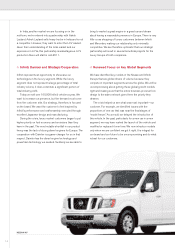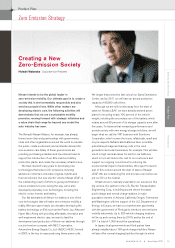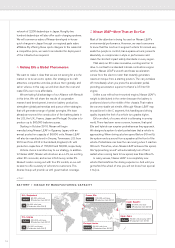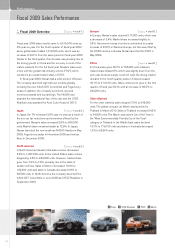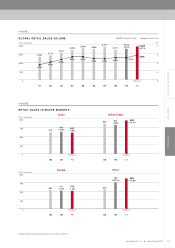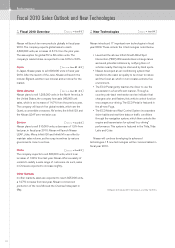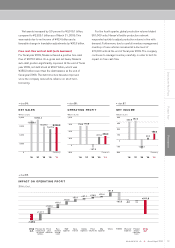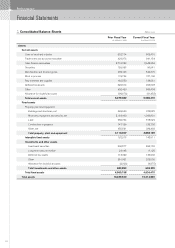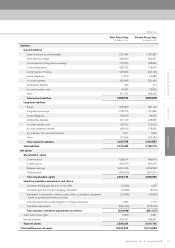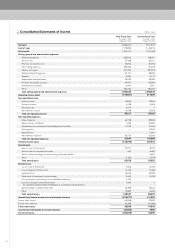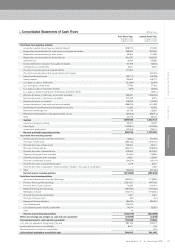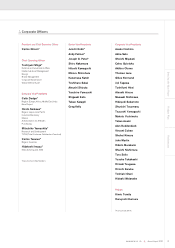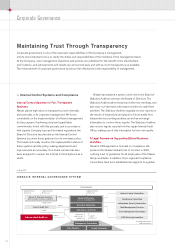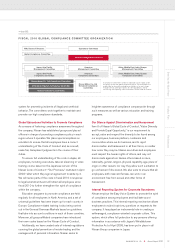Nissan 2010 Annual Report Download - page 26
Download and view the complete annual report
Please find page 26 of the 2010 Nissan annual report below. You can navigate through the pages in the report by either clicking on the pages listed below, or by using the keyword search tool below to find specific information within the annual report.
24
Credit rating
Nissan’s long-term credit rating with R&I is A- with a stable
outlook. S&P’s long-term credit rating for Nissan is BBB
with a stable outlook. Nissan’s rating with Moody’s is Baa2
with a stable outlook.
Sales finance
In conjunction with the decrease in retail sales, total
financial assets of the sales finance segment decreased by
6.1% to ¥4,355.9 billion from ¥4,638.9 billion in fiscal year
2009. The sales finance segment generated ¥77.5 billion in
operating profits. The improvement in profitability was due to
improved borrowing rates and the decrease in allowance for
bad debt, compared to the prior year.
Investment policy
Capital expenditures totaled ¥273.6 billion, which was 3.6
percent of net revenue. Due to the economic crisis, the
company reduced capital expenditures, compared to the
prior year. However, in order to ensure Nissan’s future
competitiveness, certain key projects were maintained. For
fiscal year 2010, the company remains committed to
strategic initiatives, such as the Zero-Emission Nissan LEAF
electric vehicle, and the V-Platform Global Compact Car.
R&D expenditures totaled ¥385.5 billion. These funds
were used to develop new technologies and products. One
of the company’s strength is its extensive collaboration and
development structure with Renault’s R&D team, resulting
from the Alliance.
Dividend
Nissan’s strategic actions reflect not only its long-term
vision as a global company that creates sustainable value
but also the company’s commitment to maximizing total
shareholder return. Based on the current state of the
industry and weighing in the risks and opportunities for this
year, Nissan is planning to reinstate dividend payments for
fiscal year 2010 at ¥10 for the full year (¥5 for the interim
and ¥5 at year-end).
Fiscal 2010 Outlook
In fiscal year 2010, risks include the continuing strong yen,
increasing raw material costs, ongoing uncertainly in world
markets and instability and volatility within the euro-zone.
Opportunities include favorable foreign exchange rates, the
TIV increase in China, acceleration of Alliance synergies
with Renault and further strategic cooperation with Daimler.
In light of the outlook for fiscal year 2010, the company filed
its forecast with the Tokyo Stock Exchange. Assumptions
included retail unit sales of 3,800,000 units, which is an
increase of 8.1 percent from the prior year, and
foreign-exchange-rates of ¥90 to the dollar and ¥120 to
the euro.
• Net revenues are expected to be ¥8,200 billion.
• Operating income is expected to be ¥350 billion.
• Net income is forecasted to be ¥150 billion.
• R&D expenses will amount to ¥430 billion.
• Capital expenditures are expected to be ¥360 billion.
The evolution in operating profit, compared to the fiscal
year 2009 results, is mainly linked to five key factors:
• The increase in raw material and energy costs is
expected to be a negative ¥100 billion.
• Marketing and Sales expenses are expected to be a
negative ¥140 billion due to normalization of fixed
expenses, such as advertising costs and the rise in
incentives as volume increases.
• Purchasing cost reduction is expected to be a positive
¥160 billion.
• Volume and mix should be a positive of ¥270 billion
due to the anticipated increase in sales volume.
• Others are a negative ¥151.6 billion, due mainly to
unfavorable foreign exchange, the increase in
manufacturing costs and a partial normalization in labor
costs to pre-crisis levels.
The company strives to achieve a positive free cash flow,
based on the assumptions above. The company believes
that this is an achievable target, as they will continue with
their efforts to improve working capital and control capital
expenditures.
(All figures for fiscal year 2010 are forecasts, as of May 12, 2010.)
Refer to Chart
09
Refer to Chart
10
Refer to Chart
11


